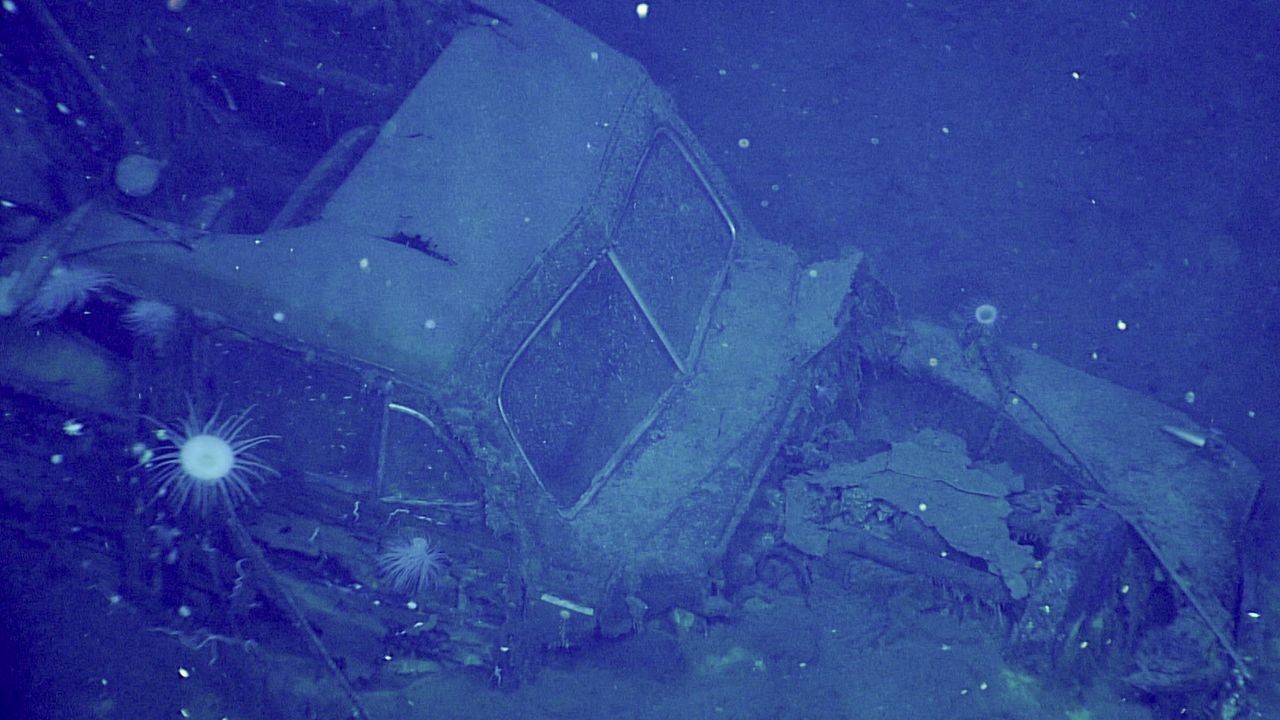Introduction: A Discovery That Defied History
The Pacific Ocean guards its secrets well. In its crushing depths, where sunlight never penetrates and pressure would flatten a human body instantly, history lies preserved in eerie stillness. It was in this alien landscape, nearly three miles beneath the surface, that a team of NOAA researchers made one of the most perplexing discoveries in maritime archaeology—a discovery that would rewrite our understanding of one of World War II’s most famous warships.
Resting silently inside the decaying hangar of the USS Yorktown, an aircraft carrier lost in the Battle of Midway, was something no historian or naval expert expected to find: a pristine 1940s Ford Super Deluxe Woody station wagon, its black paint still visible under layers of marine sediment, its chrome bumpers catching the submersible’s lights with an almost ghostly gleam.
This wasn’t just any car. The Ford Woody was a symbol of pre-war American optimism—a handcrafted luxury vehicle with elegant wood paneling, designed for family road trips along sunny coastal highways, not for the bowels of a warship. Yet here it sat, perfectly preserved in a steel tomb that had claimed 141 lives when it sank in 1942.
The discovery raised immediate questions:
- How did a civilian luxury car end up inside an active warship?
- Why wasn’t it removed when the ship was being lightened during its final battle?
- Whose car was it, and what personal story did it represent?
This is the untold mystery of the Yorktown’s ghost car, a relic that bridges two worlds: the carefree elegance of pre-war America and the brutal reality of the Pacific War. It’s a story that forces us to reconsider what we know about life aboard these floating fortresses, and about the personal sacrifices made during humanity’s greatest conflict.
Chapter 1: The Impossible Find—A Car Where It Shouldn’t Be
The Moment of Discovery
In October 2025, NOAA’s deep-sea exploration team aboard the research vessel Okeanos Explorer was conducting routine scans of the USS Yorktown’s wreck site near the Papahānaumokuākea Marine National Monument. Using state-of-the-art remotely operated vehicles (ROVs) equipped with 4K cameras and laser scanners, their mission was to document the wreck’s deterioration and marine life colonization.
Dr. Emily Carter, the lead marine archaeologist, recalled the moment everything changed:
“We were mapping coral growth on the hangar deck when the ROV’s lights hit something unusually reflective. At first, we assumed it was aircraft wreckage—maybe part of a Dauntless bomber. Then the shape became clearer… four wheels, a hood, a windshield. My team started shouting over the comms—’That’s a car! That’s a damn car!'”
The vehicle was immediately identifiable as a 1940 or 1941 Ford Super Deluxe Woody station wagon, a high-end model featuring:
- Handcrafted maple and mahogany wood paneling
- Art Deco chrome detailing
- A canvas convertible top
- Distinctive flared wheel arches
Most remarkably, a license plate still clung to the bumper, partially legible: “SHIP SERVICE”—a marking typically used for official naval base vehicles.
Why This Discovery Was So Baffling
The presence of this civilian vehicle aboard an active warship defied all logical explanations:
- Space was sacred on aircraft carriers. Every square foot was allocated for aircraft, ammunition, or crew quarters. A luxury car served no combat purpose.
- The Yorktown had been in combat readiness. After barely surviving the Battle of Coral Sea, it underwent emergency repairs at Pearl Harbor before rushing to Midway. There would have been no time or reason to load a civilian vehicle.
- During its sinking, the crew jettisoned everything non-essential—including planes and guns—to lighten the ship. Why wasn’t this heavy car pushed overboard?
Dr. James Delgado, a renowned maritime historian consulted on the discovery, noted:
“In twenty years of studying warship wrecks, I’ve never seen anything like this. It’s as if we found a grand piano in a submarine. The very presence of this vehicle changes how we view life aboard these ships.”
Chapter 2: The USS Yorktown’s Final Mission—Context for the Mystery
To understand how a luxury car ended up on the Yorktown, we must revisit the ship’s final, desperate days—when this floating city of 2,200 men became the epicenter of a battle that changed world history.
A Warship on Borrowed Time
The USS Yorktown (CV-5) was no ordinary carrier. As the lead ship of its class, it represented cutting-edge naval technology in 1937. By June 1942, it had already become a legend:
- December 1941: Survived Pearl Harbor by being at sea
- May 1942: Took heavy damage at Coral Sea but still launched decisive strikes
- June 1, 1942: Limped into Pearl Harbor with a 30-foot hole in its side
What happened next became known as the “72-Hour Miracle.” Normally requiring months of repairs, the Yorktown was made battle-ready in just three days through round-the-clock work by 1,400 dockworkers. Sailors recalled:
“They were welding as we pulled away from the dock. Men were still painting the flight deck when the first planes took off.”
The Battle of Midway: Point of No Return
On June 4, 1942, the Yorktown launched its planes against the Japanese fleet. In a pivotal moment, its SBD Dauntless dive bombers helped sink two enemy carriers (Akagi and Sōryū). But retaliation came swiftly:
- 10:30 AM: Hit by three bombs that started raging fires
- 4:30 PM: Torpedoed twice, causing a 26-degree list
- June 7: After a night of desperate damage control, the ship was abandoned
As the crew prepared to evacuate, they threw everything non-essential overboard:
- 12 aircraft pushed off the deck
- Anti-aircraft guns detached and dumped
- Fuel lines purged to prevent explosions
Yet the Ford Woody remained below. Why?
Chapter 3: Investigating the Ghost Car—Four Compelling Theories
Historians and naval experts have proposed several explanations for the car’s presence, each revealing different aspects of wartime life.
Theory 1: An Admiral’s Personal Vehicle (Most Plausible)
High-ranking officers often had privileges unimaginable to regular sailors. Both Rear Admiral Frank Jack Fletcher (task force commander) and Captain Elliot Buckmaster (Yorktown’s CO) are prime candidates:
- Precedent: Admiral Halsey kept a personal car aboard the USS Enterprise
- Port Convenience: Senior officers needed transport during shore leave
- Last-Minute Loading: Possibly driven aboard during the Pearl Harbor scramble
Naval records show Buckmaster was particularly fond of automobiles. A 1941 letter mentions:
“The Captain has taken delivery of a new station wagon for family use. He’s quite proud of the woodwork.”
Theory 2: Ship’s Service Vehicle (Official Use)
The “SHIP SERVICE” plate suggests possible official duties:
- Base Transport: Used to ferry supplies or personnel at Pearl Harbor
- Medical Evacuation: Could carry wounded in port
- VIP Transport: For visiting dignitaries
However, the Woody’s luxury trim seems excessive for utilitarian purposes.
Theory 3: Cargo for Reassignment (Unlikely but Possible)
Some speculate it was being transported:
- To Hawaii: For a naval officer’s family relocated due to war
- As Spare Parts: Though no records confirm vehicles as cargo
- For Morale: As a reward for crew (though this seems far-fetched)
Theory 4: Forgotten in the Chaos (Human Error)
The most haunting possibility—that amid the 72-hour repair frenzy, the car was simply overlooked until it was too late. Sailor diaries describe:
“We were tossing things overboard just to stay afloat. Maybe no one remembered it was down there.”
Chapter 4: The Science of Preservation—Why the Car Survived
The Ford Woody’s condition after 83 years underwater is itself a marvel of preservation. Key factors:
Deep-Sea Environmental Conditions
- Pressure: 6,500 psi prevents oxygen penetration, slowing rust
- Temperature: 34°F (1°C) dramatically reduces bacterial decay
- Darkness: No sunlight means no algae/plant growth
Material Resilience
- Wood Panels: Mahogany’s natural oils resist water damage
- Chrome Plating: Nickel layer protects underlying steel
- Vacuum Effect: Sealed compartments trapped air pockets
Positioning in the Wreck
- Protected Location: Inside the hangar, shielded from currents
- Sediment Cover: Fine silt acted as a protective blanket
Dr. Sylvia Earle, oceanographer, explains:
“At these depths, time stands still. That car is in better condition than most 1940s vehicles left in barns on land.”
Chapter 5: Other Eerie Finds—The Yorktown’s Time Capsule
The NOAA expedition documented more haunting artifacts:
The Lost Squadron
- Three intact SBD Dauntless bombers, one still carrying its 500-pound bomb
- Flight helmets and goggles resting on wings
- A pilot’s chart table with legible navigation notes
The Forgotten Mural
A 42-foot-long painting in an elevator shaft depicted:
- Ports visited (Panama, San Diego, Pearl Harbor)
- Battle honors (Coral Sea engagement)
- Cartoon caricatures of crew members
Personal Effects
- A sailor’s shoe with socks still inside
- Rusted but recognizable Coca-Cola bottles
- A love letter sealed in a waterproof pouch
Chapter 6: The Human Story—Whose Car Was It Really?
Beyond military history, this is a story about people. Consider:
Possible Owner Profiles
- Captain Buckmaster’s Family Car
- His wife and children lived in Hawaii
- May have planned weekend drives that never happened
- A Pilot’s Pride and Joy
- Naval aviators were famously well-paid
- Could have shipped it for post-victory celebrations
- A Gift Never Given
- Perhaps intended for a sailor’s postwar life
- Frozen in time like so many wartime dreams
The Emotional Weight
Dr. Carter reflects:
“That car represents interrupted lives. Someone polished those chrome strips, filled the tank, turned the key. Then history intervened.”
Chapter 7: Unanswered Questions and Ongoing Research
The discovery has sparked new investigations:
Pending Research
- Dendrochronology: Dating the wood to confirm manufacturing year
- Paint Analysis: Tracing original color and dealership
- Naval Records Search: Seeking cargo manifests from Pearl Harbor
Preservation Dilemma
- Leave in situ: Respect as a war grave
- Recover for study: Technological challenges are immense
Parallel Mysteries
Similar oddities found in wrecks:
- A motorcycle in the USS Arizona
- Grand piano aboard HMS Hood
- Baseball gear on Japanese submarine I-52
Conclusion: Why This Mystery Matters
The Yorktown’s ghost car is more than a curiosity—it’s a metaphor for war itself:
- A peacetime luxury trapped in a warrior’s grave
- A reminder that behind battle strategies were real people with personal lives
- An object that outlasted its owners through sheer circumstance
As Dr. Delgado concludes:
“This Ford Woody is now the world’s deepest parking spot. But more importantly, it’s a time machine connecting us to those tense days when the fate of nations hung in balance, and a car in a hangar was the last thing on anyone’s mind.”
The ocean keeps its secrets well. But sometimes, when the lights of science pierce the darkness, we’re granted glimpses into stories we never knew to ask about—stories that change how we remember the past.


